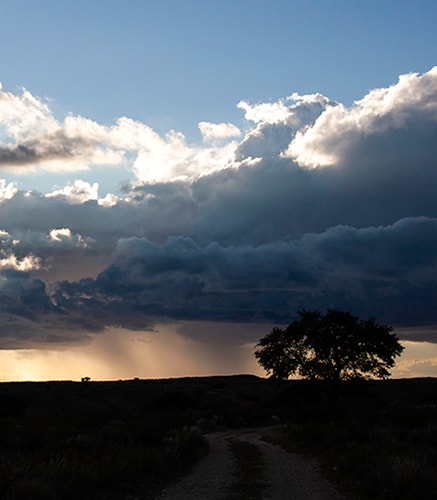For John Onderdonk, land management is in his blood. A fourth-generation cattle rancher, he oversees his family’s 9,000-acre ranch in central California. He is also part owner of a sustained yield timber ranch located in the southern Sierra Nevada, and previously served as Chief Sustainability Officer at the California Institute of Technology.
Today, John works as Northern Trust’s National Practice Leader of Agriculture Properties — a role that allows him to tap into his deep personal experience to help clients navigate the challenges and opportunities that come with purchasing, owning and inheriting farmland, ranches and timberland. We caught up with him to discuss his upbringing, how he works with clients, and what investors who are interested in agricultural assets should know.
John, take us back to your childhood. What was it like growing up in a cattle ranching family?
Ranching has always been a huge part of my family. It started with my great grandfather, who was able to acquire one of the original Spanish Ranchero Land Grant ranches in California. The original ranch was in the Conejo Valley and was a working cattle ranch that also offered a place for the family to vacation, enjoy the outdoors and step away from the city.
Unfortunately for the Conejo Valley ranch, Highway 101 was built through the valley in the ’50s, and the ranch was in the path of progress. Eventually, my grandfather made the decision to liquidate the entire property. That prompted the family to purchase a new ranch near central California. While I was born and raised in Pasadena, I spent many weekends and summers at the ranch working. Growing up in both of those worlds was a formative part of who I came to be professionally and one of the reasons why I landed in my role at Northern Trust.
Tell us more about your work at Northern Trust? How do you help clients?
Many of the families I work with have stories like my own. As the intergenerational dynamics of the family play out, there is a desire to retain the properties, but also an understanding that evolution is necessary. This is a complex part of the equation that is hard for all parties involved. It's hard for the families and the beneficiaries because of the emotional ties to the land and the expectations of the older generations. But it’s also hard for the individuals who are working the land.
My role is to serve as a bridge between the families who own these agricultural assets and the individuals who work on them. We do that in two ways: In certain instances, we may operate as a formal fiduciary, acting as a trustee of a trust that owns a ranch. In other instances, we may serve as an advisor, providing consultation to our clients on how to navigate the challenges of owning agricultural assets.
What is driving the growing interest in owning agricultural assets?
In our culture in the United States, there is an ongoing reverence and romanticization for the lifestyle of the cowboy or the frontiersman. Investors are also recognizing that agricultural assets can provide not only the opportunity to build a legacy, but portfolio diversification as well.
According to data from the National Council of Real Estate Investment Fiduciaries, from 1992 to 2023 U.S. farmland generated an average annual return of 10.52% — competitive returns that outpace many major asset classes. Additionally, there's low volatility in farmland, with 6.61% annually compared to 17.71% in the S&P 500.
What are some of the challenges that may come with owning an agricultural asset?
It’s important to recognize that as much as the investment is stable, the actual operation of farming and ranching is very volatile and brings a lot of uncertainty because many of the variables in the business are outside of your control. Whether it's the climate, commodity prices, input costs, natural disasters — there are many outside forces that can impact your business. Additionally, there's a new set of dynamics that are posing challenges to owners of agricultural assets: the economic uncertainty we’re seeing in the wake of recent tariff policy.
Farming and ranching are businesses where cash-flow are critical. You typically receive a pay check once, twice, maybe a handful of times a year when selling cattle or harvesting crop. The rest of the year, you must focus on managing that cash flow. It’s important to be eyes wide open when coming into the operation of farming or ranching, with a keen interest in managing the asset successfully.
It’s not uncommon for agricultural asset owners to supplement with capital calls from off-farm income. Margins across farming in general are very stressed. The reality of these low-profit margins places a premium on optimizing the operations to try to boost profit, which is a very difficult process when you don't control all the costs.
What are the opportunities and innovations that can help agricultural property owners stay profitable?
The tension between evolution and continuity are an extremely difficult part of owning a ranch. Whether it’s nostalgia or a reverence for the way prior generations operated, the momentum behind continuity on family ranches and farms is massive.
That said, there are plenty of opportunities in agriculture that are arising, and it's to the benefit of the farmer and rancher to understand them. A big area where I see opportunity is technology, particularly in AI and robotics. There have also been advancements in “tried and true” technologies such as regenerative practices, soil organics and biological symbionts. There are always risks associated with new technologies, but being thoughtful about how those tools are deployed can provide opportunities for increased profitability.
What is the ‘why’ behind the work you do — both on the ranch and here at Northern Trust?
I've stepped forward in my family to help navigate these intergenerational challenges and help steward that legacy for the family. It’s important to me that we keep the ranching tradition alive in our family and maintain the property so that my children and grandchildren and cousins and so forth can enjoy it. That is my ‘why’ when it comes to the ranch. I’m fortunate now to be working at Northern Trust where that ‘why’ carries through with my clients. I feel privileged that I get to help other folks who are stewarding lands across the country navigate those exact same challenges. The optimism and excitement that I get to experience while helping others create long-term benefit through the proper stewardship of working lands — that’s my motivation.
This article was adapted from the episode of The Road to Why Podcast, “Why is Everyone Buying Ranches?” Listen to John’s full conversation with Eric Czepyha, Director of Business Services, on your favorite podcast platform.



